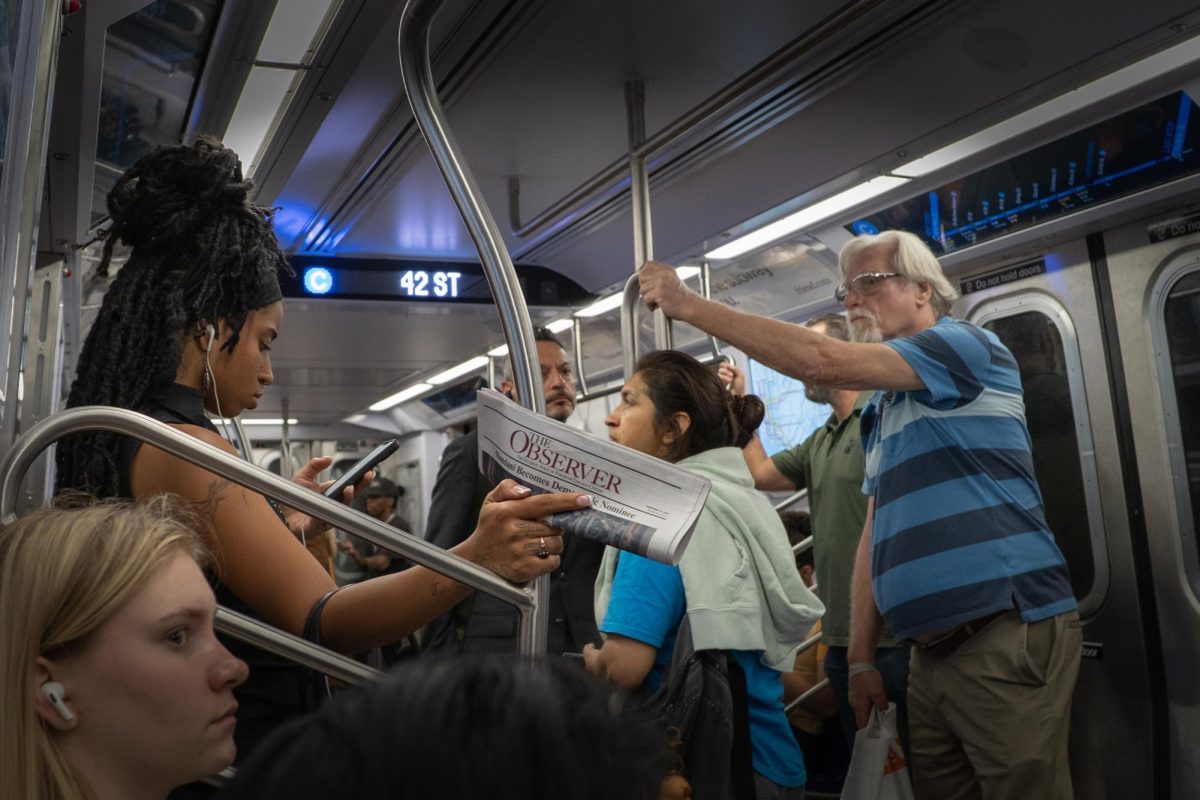Traffic was at a standstill one Tuesday night as a Ram Van departed from Fordham University’s Rose Hill campus. Inside, students sat quietly, taking it easy after a long day of classes. Some eyed the sparkling Hudson River through the windows. Others spoke about dinner plans, coursework and whatever else had happened that day. Then, amid conversations, someone posed a dramatic hypothetical: What would happen if the Ram Van disappeared?
Among the passengers was Sofiya Waraich, Fordham College at Lincoln Center (FCLC) ’25. She laughed at the question, but chimed in, saying, “If the Ram Van disappeared, it would affect me,” Waraich said. “I’m in my last semester, and I did not want to take the Metro-North up to Rose Hill.”
Steady and dependable, Fordham’s Ram Van is more than a campus shuttle — it’s one of those services students don’t think much about, precisely because they never have to. It’s always there.

“We understand there is a negative connotation to students driving vans.” Plinio Gonzalez, Director of University Transportation
Tucked behind the Ram Van headquarters at Rose Hill is the office of Plinio Gonzalez, Fordham College at Rose Hill (FCRH) ’08, the director of university transportation. His office is teeming with Fordham memorabilia and merchandise — right down to Ram Van-themed stickers — but what’s most striking is the monitors that display real-time data on each van: fuel levels, odometer readings, engine warnings and hours on the road, to name a few.
“We understand there is a negative connotation to students driving vans,” Gonzalez said. “Parents are like, ‘I would never have my Susie drive a 15-passenger van in the city!’”
Despite those concerns, student safety is anything but an afterthought at Ram Van. Before taking the wheel, all drivers complete 20 hours of training. During a massive rainstorm in the city in 2023, Gonzalez said that at that time, he made sure to keep safety at the front of his mind. He said that if students were uncomfortable driving in a storm, “they don’t have to drive.”
Once on the road, several precautionary systems are in place to ensure safe travel.
Inside every van, passengers may notice a window sticker that reads: “ATTENTION: Video Surveilled – You May Be Monitored by SAMSARA Video Recording System.”
Not to worry, Gonzalez said, SAMSARA isn’t there to watch students — it’s there to protect them. Introduced in 2017, the system allows the department to monitor van locations in real time. Each Ram Van is now equipped with AI dash cameras, GPS tracking and performance-monitoring technology designed to ensure safety and efficiency.
“The idea of getting paid to drive, I was like, ‘yeah, count me in.’” Plinio Gonzalez, Director of University Transportation
Gonzalez has been with the Ram Van since 2004, starting as a first-year student in a work-study job that grew into a career. “The idea of getting paid to drive, I was like, ‘Yeah, count me in,’” he said.
That sentiment is shared by many. Every day, student drivers navigate unpredictable traffic, the personalities of different passengers and other drivers on the road. Gonzalez said the Ram Van transports approximately 250,000 passengers each year, with ridership up 8% in 2025.
The very first time a Ram Van drove from Rose Hill to Lincoln Center was on October 1, 1979. A Ram Van ride in the 1990s cost $2; however, according to Gonzalez, for the last twelve years, one thing hasn’t changed: the ticket price has remained at $3.50 — a remarkable stalwart.
Considering inflation, congestion pricing and the rising costs of city life, the fare can be taken as a quiet but meaningful gesture from the department.
Along with the steadfast price, the Ram Van has continued to be a constant in the lives of intercampus commuters.
“Last time I spoke to President Tetlow, she was like, ‘Oh my god, I hear Ram Vans are like a cult because they’re so strongly knit,’” Gonzalez recalled with a laugh.
That camaraderie remains strong.

For dispatchers like Alice Fairman, FCRH ’26, the job isn’t just about managing vans — it’s about managing the chaos of New York City driving.
“I think people that are a little bit intense and like to be in stressful situations,” Fairman said of who makes good Ram Van drivers. “You have to be okay with being stressed out and with being in a position where you’re kind of always on the line.”
“New York and New Jersey drivers aren’t that good, in my opinion.” Alice Fairman, FCRH ’26
But what does it really mean to be a good or bad driver? Two researchers from West University of Timișoara, Romania, produced a study with the Journal of Research in Personality that found there are actually situational factors that are attributed to good or bad driving. They found that dangerous driving behaviors — such as rule violations and aggression — can vary significantly from week to week, depending on personality traits like conscientiousness and emotional stability, as well as changing situational factors like mood, traffic pressure and the length of a drive.
It’s no wonder that one of the densest metropolitan areas in America has a negative driving reputation.
“New York and New Jersey drivers aren’t that good, in my opinion,” Fairman said.
From late-night rides to daily commutes, the Ram Van keeps Fordham moving, facing good and bad drivers alike.

Meghan Goulet, GSBLC ’25, who currently works as a maintenance coordinator for Ram Van, said she likes to set the mood while driving, often curating a playlist to match the ride. For many Ram Van drivers, the music is one of the few things they have full control over, making each trip feel a bit like being a DJ behind the wheel — if only for a short time.
“I’ve been on a few vans where the driver just leaves it silent, and I’m like, ‘That’s an interesting choice.’ But yeah, I definitely always play my music,” Goulet said from the Ram Van offices.
“I took a wrong turn and nobody on the van would have noticed that I did, I could have just played it all cool. But I screamed a really bad word and when I took the wrong turn. I shouldn’t have done that.” Jeremy Andre, GSBRH ’28
On another late-night drive back to Lincoln Center, Jeremy Andre, Gabelli School of Business at Rose Hill ’28, had just started working for the Ram Van. He was still new to the job.
“I took a wrong turn, and nobody on the van would have noticed — I could have just played it cool,” Andre recalled. “But I screamed a really bad word when I did it. I shouldn’t have done that … but like, objectively, nothing bad happened.”
Even for new drivers, it takes time to get used to the route. But all in all, the Ram Van remains a safe, reliable part of Fordham — one that the university would be at a loss without.
CORRECTION: A previous version of this article incorrectly wrote Meghan Goulet’s title as a dispatcher and college as FCLC ‘25. The article has been updated to reflect the correct title and college.









